Following a long sleep-deprived night, we were dropped off at the side of some busy road in Mumbai where a string of autos were waiting to feast on the new arrivals. Another woman, also on her way to the airport, was getting hassled so Priti stepped in and started yelling at them in Hindi and demanded a much more reasonable price for the three of us. We had learned from Sapna that the only surefire way to get a response from many of the people is by yelling at them, and unfortunately we had to resort to this tactic on more than one occasion. At the airport, we were impressed how easy it was to purchase the tickets, in cash no less. Imagine trying to do that in the States. The one-hour flight to Udaipur on Kingfisher Airlines was nice. The auto into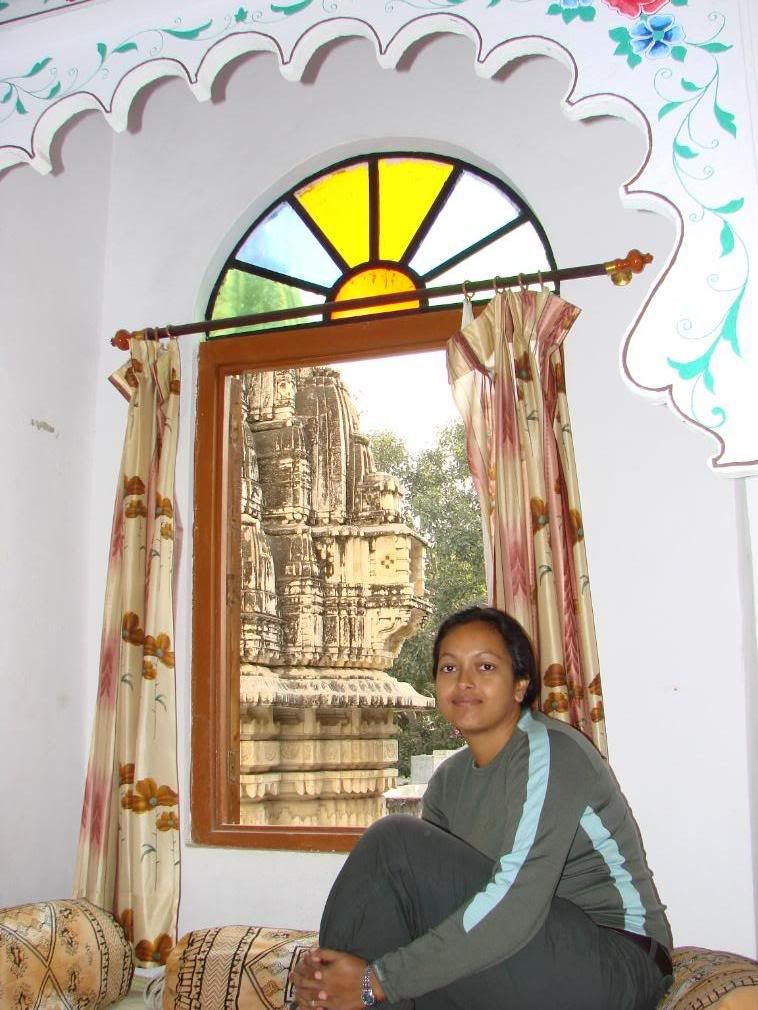 town was an interesting ride, as the streets were incredibly narrow and the driver had to stop several times and back up to let the oncoming vehicle squeeze by. We walked around for awhile and found a guesthouse with a nice view of the Lake Palace. Unfortunately, the hot water did not work and the bathroom window was broken, giving a full-on view to the adjacent hotel. When we complained, they put us into a much better room the following day. This room was beautiful with hand painted motifs on the walls, stained glass windows, and a window seat so close to one of the temples that we could nearly reach out and touch it, all for 300 rupees ($7.50).
town was an interesting ride, as the streets were incredibly narrow and the driver had to stop several times and back up to let the oncoming vehicle squeeze by. We walked around for awhile and found a guesthouse with a nice view of the Lake Palace. Unfortunately, the hot water did not work and the bathroom window was broken, giving a full-on view to the adjacent hotel. When we complained, they put us into a much better room the following day. This room was beautiful with hand painted motifs on the walls, stained glass windows, and a window seat so close to one of the temples that we could nearly reach out and touch it, all for 300 rupees ($7.50).
After enjoying thalis (4-5 different vegetarian dishes with rice and/or bread) for breakfast), we walked around the maze-like city of Udaipur, where winding roads veered off into alleyways about as wide as one car. Yet, despite the size of the roads, we still saw a few SUVs. There were many cows on the roads as well, and we saw them cause several traffic jams.  We noticed people would stop and give them mythai (me-tie=sweets), and Jason was jealous when he saw on lucky cow chomping on a handful of ladoos. Our first sight was a nearby Hindu temple; inside were a group of mostly older women sitting on the floor, chanting bhajuns (worship songs) in front of a black avatar of Shiva. In the afternoon we visited the City Palace. As we neared the entrance, another tourist randomly handed us two tickets…score! Like the city itself, the palace felt like a maze. Each of the scores of rooms we visited was an interior decorator’s dream come true, adorned with antiques, hand-painted ceilings, and magnificent views.
We noticed people would stop and give them mythai (me-tie=sweets), and Jason was jealous when he saw on lucky cow chomping on a handful of ladoos. Our first sight was a nearby Hindu temple; inside were a group of mostly older women sitting on the floor, chanting bhajuns (worship songs) in front of a black avatar of Shiva. In the afternoon we visited the City Palace. As we neared the entrance, another tourist randomly handed us two tickets…score! Like the city itself, the palace felt like a maze. Each of the scores of rooms we visited was an interior decorator’s dream come true, adorned with antiques, hand-painted ceilings, and magnificent views.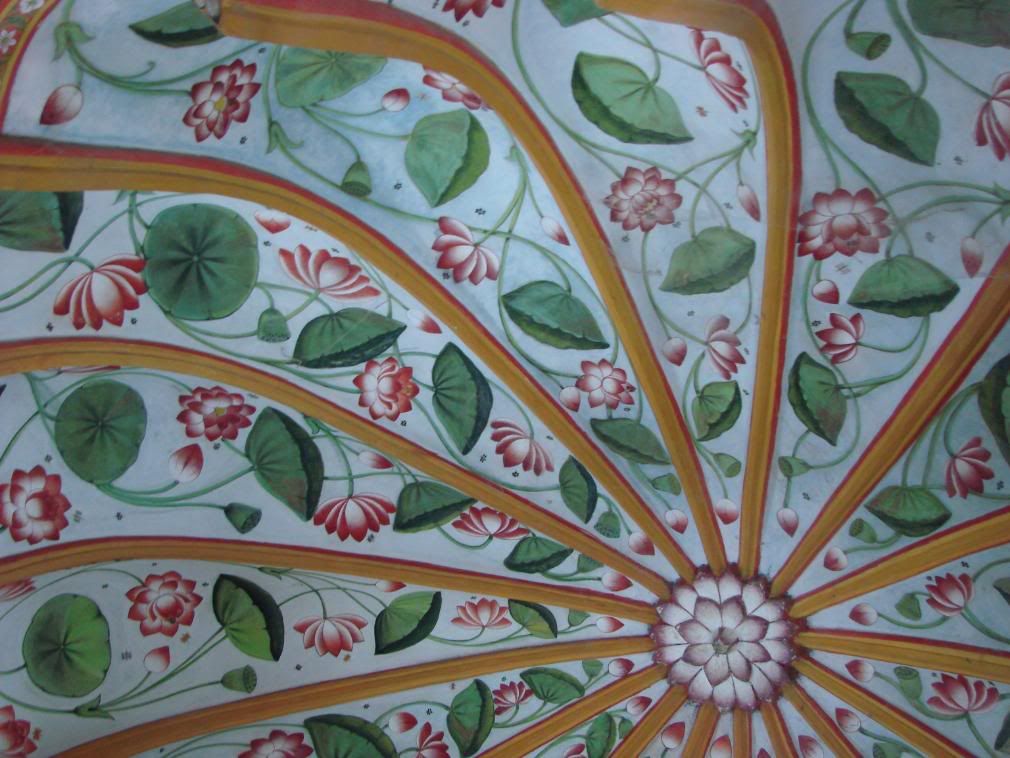 On our way back to our room, we listened to a local musician playing a Rajasthani stringed instrument at one of the lakeside ghats, which are platforms with steps leading down to the water. Jason put a down payment on a CD because he wanted to hear it first since it was just a copied disc. We agreed if we liked it we’d buy it but if not, we’d get our money back. As we ate an uninspiring dinner in the guesthouse restaurant, we tried listening to it but only a few of the tracks actually contained music. When we saw him again the following day, he had just made another sale to an older couple. When Jason explained the problem the musician became very defensive. The female tourist snidely remarked, “who cares, it’s only 300 rupies” to which Jason immediately offered to sell it to her for that price, which she of course declined. The musician wasn’t going to return our money until Priti started to raise her voice in Hindi, after which he held up his end of our agreement.
On our way back to our room, we listened to a local musician playing a Rajasthani stringed instrument at one of the lakeside ghats, which are platforms with steps leading down to the water. Jason put a down payment on a CD because he wanted to hear it first since it was just a copied disc. We agreed if we liked it we’d buy it but if not, we’d get our money back. As we ate an uninspiring dinner in the guesthouse restaurant, we tried listening to it but only a few of the tracks actually contained music. When we saw him again the following day, he had just made another sale to an older couple. When Jason explained the problem the musician became very defensive. The female tourist snidely remarked, “who cares, it’s only 300 rupies” to which Jason immediately offered to sell it to her for that price, which she of course declined. The musician wasn’t going to return our money until Priti started to raise her voice in Hindi, after which he held up his end of our agreement.
We meandered through the town, repeatedly losing our way while looking for the classic car collection of the local Raj (prince). The cars were pretty interesting, and one of them reminded Jason of the classic 1919 Rolls Royce his grandfather used to own. The collection also included the car James Bond drove in the movie Octopussy, which is screened every single night in most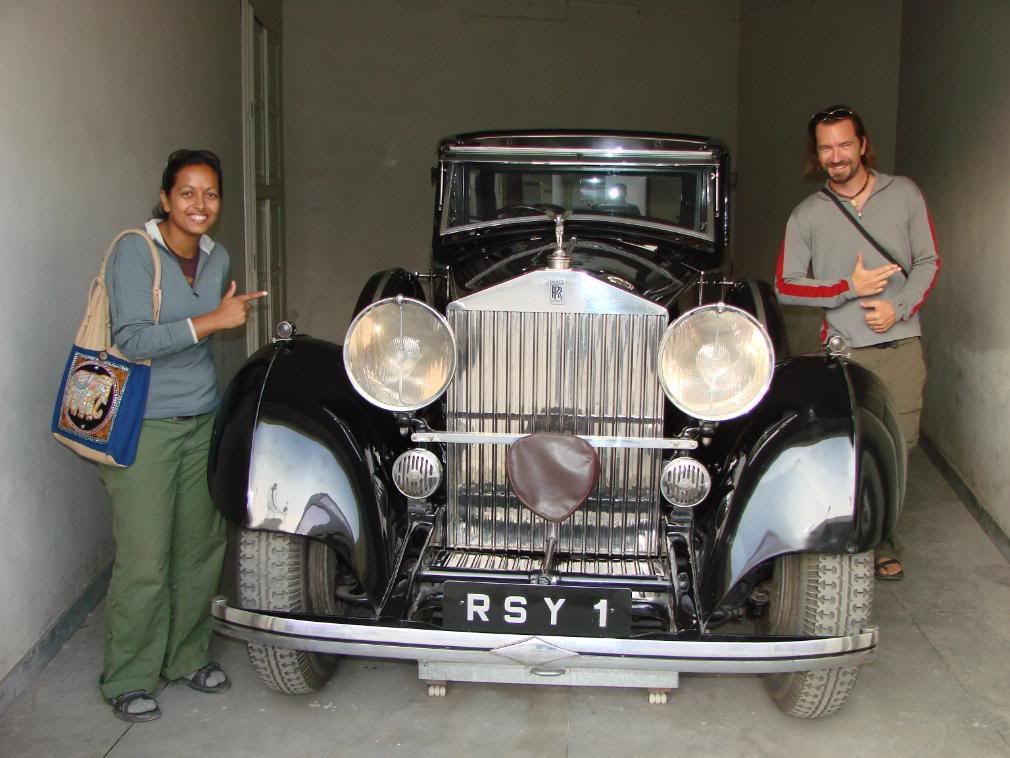 of the guesthouses in town. Somehow, we managed not to see it. The visit was also educational because we got to see some of the solar-powered vehicles that are growing in popularity in what is coming to be called the “green city.” For some reason, each of the cities in Rajasthan, like the so-called revolutions in the former Soviet Republics, has a designated color. At the conclusion of the tour, we enjoyed our complimentary soft drink; amusingly, the tickets read “Soft drinks with a touch of class.” That evening we attended a Rajasthani dance concert, and were again mesmerized by the feats of the dancers, including one woman balancing 10 bowls on her head while dancing on broken glass.
of the guesthouses in town. Somehow, we managed not to see it. The visit was also educational because we got to see some of the solar-powered vehicles that are growing in popularity in what is coming to be called the “green city.” For some reason, each of the cities in Rajasthan, like the so-called revolutions in the former Soviet Republics, has a designated color. At the conclusion of the tour, we enjoyed our complimentary soft drink; amusingly, the tickets read “Soft drinks with a touch of class.” That evening we attended a Rajasthani dance concert, and were again mesmerized by the feats of the dancers, including one woman balancing 10 bowls on her head while dancing on broken glass.
The next day we hired a driver to take us first to Fort Kumbhalgarh and then Ranakpurgh. During the long ride, we envied the future tourists who would take this day-tour after the road crews completed the paved road. Fort Kumbhalgarh is a massive now-abandoned fort that was once a key part of the Rajput empire. Just once had the fort been overtaken; three rivals joined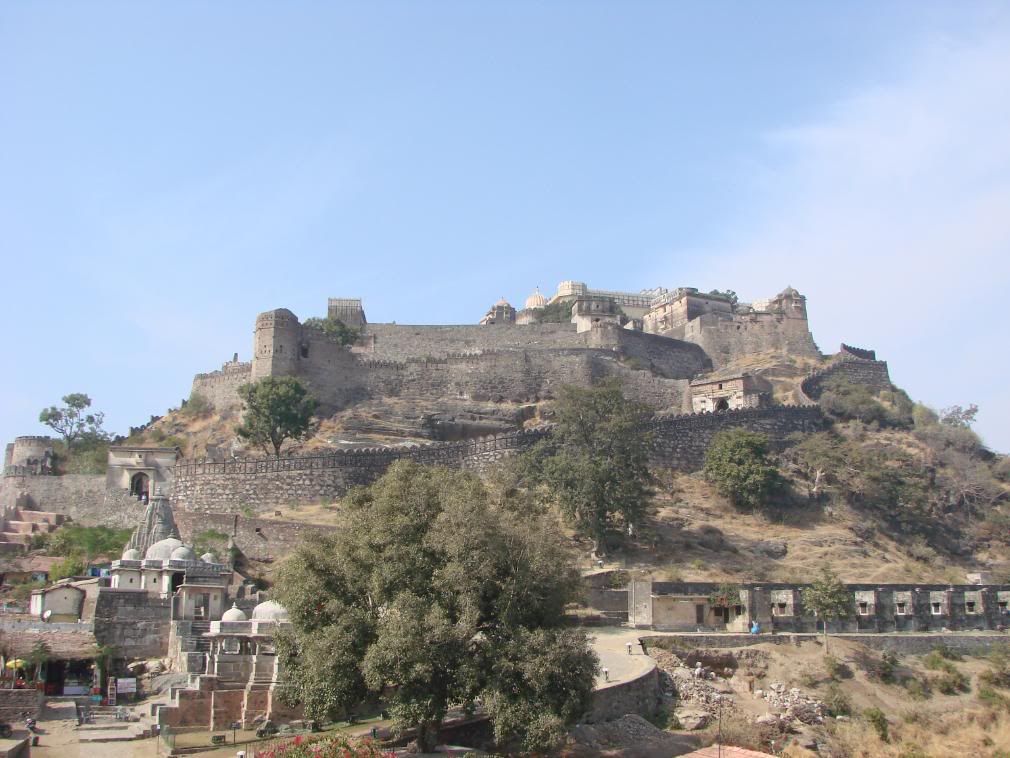 forces for the siege but only managed to hold it for two days. As we wandered around, we understood how the fort was so secure while marveling at the vastness of the compound. There were scores of temples dotted on the landscape and we ventured off the main loop to visit one of them.
forces for the siege but only managed to hold it for two days. As we wandered around, we understood how the fort was so secure while marveling at the vastness of the compound. There were scores of temples dotted on the landscape and we ventured off the main loop to visit one of them. 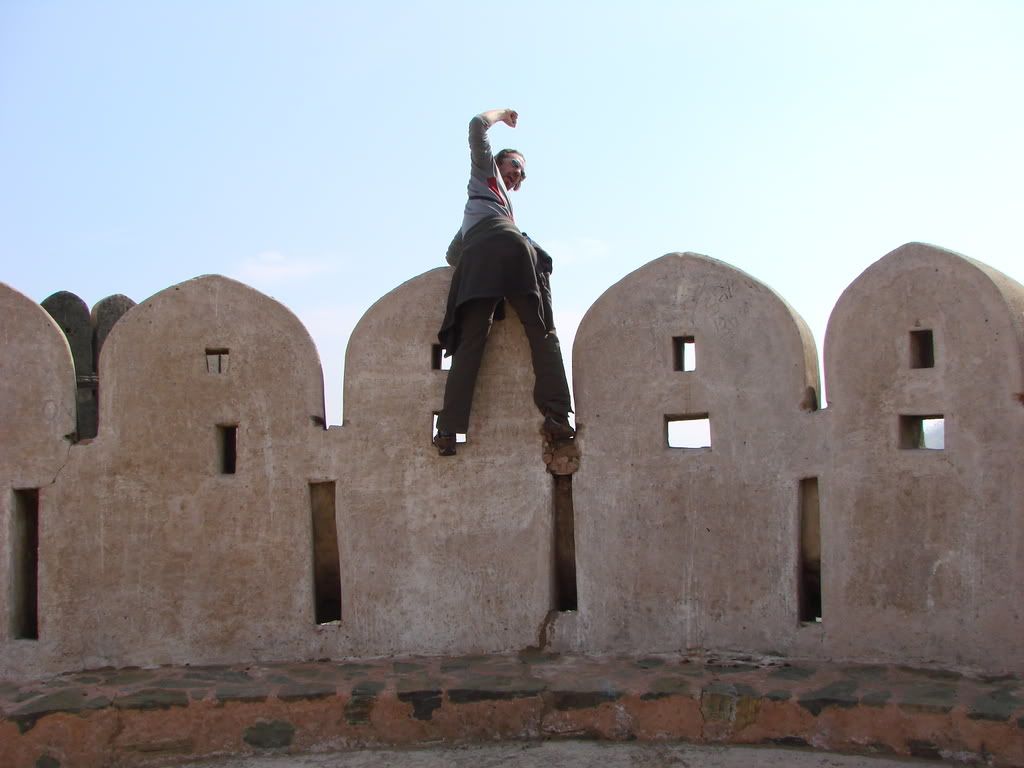 When we circuitously arrived at a beautiful temple we had spotted from atop the fort, we were the only ones around, save for one boy who seemed to be some sort of security guard. Although the temple was locked, we enjoyed the solitude away from the hordes of school kids on field trips.
When we circuitously arrived at a beautiful temple we had spotted from atop the fort, we were the only ones around, save for one boy who seemed to be some sort of security guard. Although the temple was locked, we enjoyed the solitude away from the hordes of school kids on field trips.
Then it was off to Ranakpurgh, home to a handful of Jain temples, including one of the largest in the world. Although the two places appeared to be very close on our map, the roads were incredibly windy and the journey took almost two hours.  Jainism is an offshoot of Hinduism whose adherents are strictly vegetarian. The architecture of the temple was incredible, with thousands of stone columns, each one unique. We had to remove our shoes before entering (as in most temples in Asia). Supposedly no photos of their gods are allowed, although in other Jain temples we visited they were allowed, so we’re not sure. Also, it seemed a contradiction that a religion founded in opposition to religious dogma should
Jainism is an offshoot of Hinduism whose adherents are strictly vegetarian. The architecture of the temple was incredible, with thousands of stone columns, each one unique. We had to remove our shoes before entering (as in most temples in Asia). Supposedly no photos of their gods are allowed, although in other Jain temples we visited they were allowed, so we’re not sure. Also, it seemed a contradiction that a religion founded in opposition to religious dogma should  be so concerned about taking pictures of their deities’ statues. The ride back was long and painful, and made worse as the driver appeared to be losing his sanity by the time we got back into the city.
be so concerned about taking pictures of their deities’ statues. The ride back was long and painful, and made worse as the driver appeared to be losing his sanity by the time we got back into the city.
We saved what we figured was the best for last, the Lake Palace tour, which was the number one recommendation in the guidebook. The twenty minute boat ride in Lake Pichola provided some good photos but the palace itself was somewhat disappointing, likely because our expectations were too high. The gardens were mostly barren and we weren’t even allowed to visit one area the palace, so that our visit lasted around less than an hour, despite costing 325 rupees each. Nonetheless, the palace itself is like something out of a fairytale. 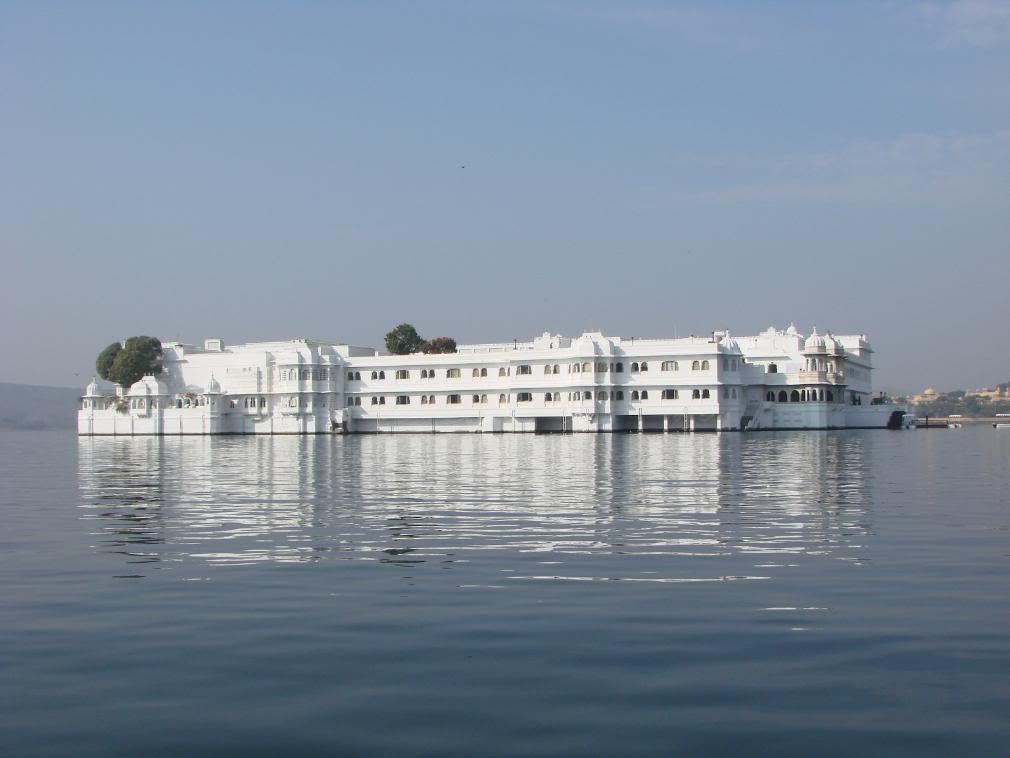 And now, another small rant. It is common for other tourists to ask us to take their picture and we usually ask them to reciprocate. It has been our experience that many of these people show little to no concern for how the pictures turn out. For example, at the Lake Palace, Jason took a nicely framed photograph of this French couple, who reciprocated by taking an out-of-focus snapshot that completely cut off the view behind us. To all of the inconsiderate poseur photographers out there, Malf has only this to say: GET IT TOGETHER.
And now, another small rant. It is common for other tourists to ask us to take their picture and we usually ask them to reciprocate. It has been our experience that many of these people show little to no concern for how the pictures turn out. For example, at the Lake Palace, Jason took a nicely framed photograph of this French couple, who reciprocated by taking an out-of-focus snapshot that completely cut off the view behind us. To all of the inconsiderate poseur photographers out there, Malf has only this to say: GET IT TOGETHER.
Later that day we caught the bus to Jodhpur, or the “blue city”, so-called due to its abundance of blue-painted houses. Once again, the bus was awful, and we suspected we were dumped on the local bus even though we had paid for a tourist bus. As we departed the bus, our noses were blasted with a mixture of exhaust and open sewage. By now we had gotten used to toxic smells, for India is covered with them, but Jodhpur was the smelliest place we had been thus far. 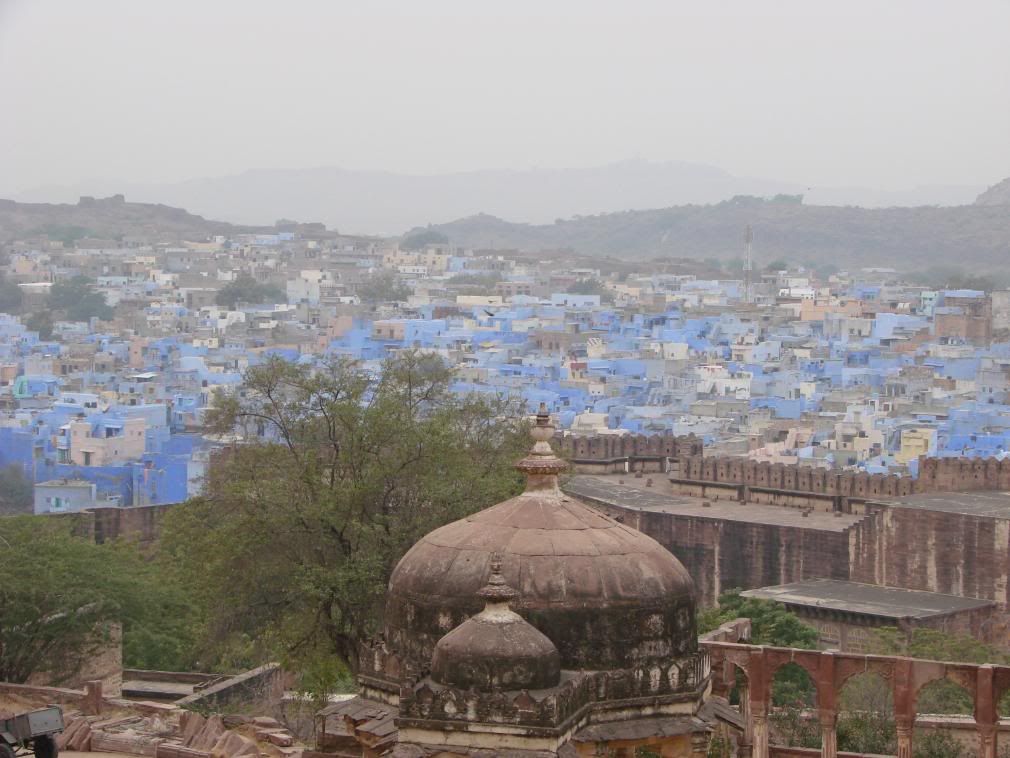 On our way to the guesthouse, we looked aghast at the open sewers that flowed alongside the streets. Similar to Udaipur, our first room was unacceptable, but they moved us into a much nicer one the following morning. The next day, we tried looking for the tour bus recommended in the guidebook but when we got there, were told instead that we would need to hire a private driver at a ridiculous price. Instead, we stopped for lunch at Priya restaurant, and had exquisite bhel puri and Delhi chat, one of Jason’s favorite dishes. As with Mirabai, we ate most of our meals at this cheap and tasty establishment. Outside the restaurant, we negotiated with an auto driver to take us on the same tour for half the price. The first stop was the Bhavan palace, one of the last palaces built in India, but which was mostly a memorial to its builder. The next stop was the fort, which offered spectacular views of the city (which was actually blue) and had a great electronic audio tour. One gem was a story about this princess who was traveling in a covered-carriage, as royal women often did. (After spending six weeks in India, we both came to understand why this was practiced since a large majority of the men have staring problems) When a newspaper’s photographer captured a glimpse of her bare ankle and printed it, the family bought up every last copy of the newspaper to ensure that no one else saw. Another highlight was the weapons gallery, with daggers that had animal-shaped ivory handles and muskets with intricate gold inlays. Our last stop of the day was the Mandore Gardens, although the auto-driver tried to finagle his way out of taking us there since dusk was approaching. We ignored his admonition to “not take too long.”
On our way to the guesthouse, we looked aghast at the open sewers that flowed alongside the streets. Similar to Udaipur, our first room was unacceptable, but they moved us into a much nicer one the following morning. The next day, we tried looking for the tour bus recommended in the guidebook but when we got there, were told instead that we would need to hire a private driver at a ridiculous price. Instead, we stopped for lunch at Priya restaurant, and had exquisite bhel puri and Delhi chat, one of Jason’s favorite dishes. As with Mirabai, we ate most of our meals at this cheap and tasty establishment. Outside the restaurant, we negotiated with an auto driver to take us on the same tour for half the price. The first stop was the Bhavan palace, one of the last palaces built in India, but which was mostly a memorial to its builder. The next stop was the fort, which offered spectacular views of the city (which was actually blue) and had a great electronic audio tour. One gem was a story about this princess who was traveling in a covered-carriage, as royal women often did. (After spending six weeks in India, we both came to understand why this was practiced since a large majority of the men have staring problems) When a newspaper’s photographer captured a glimpse of her bare ankle and printed it, the family bought up every last copy of the newspaper to ensure that no one else saw. Another highlight was the weapons gallery, with daggers that had animal-shaped ivory handles and muskets with intricate gold inlays. Our last stop of the day was the Mandore Gardens, although the auto-driver tried to finagle his way out of taking us there since dusk was approaching. We ignored his admonition to “not take too long.” 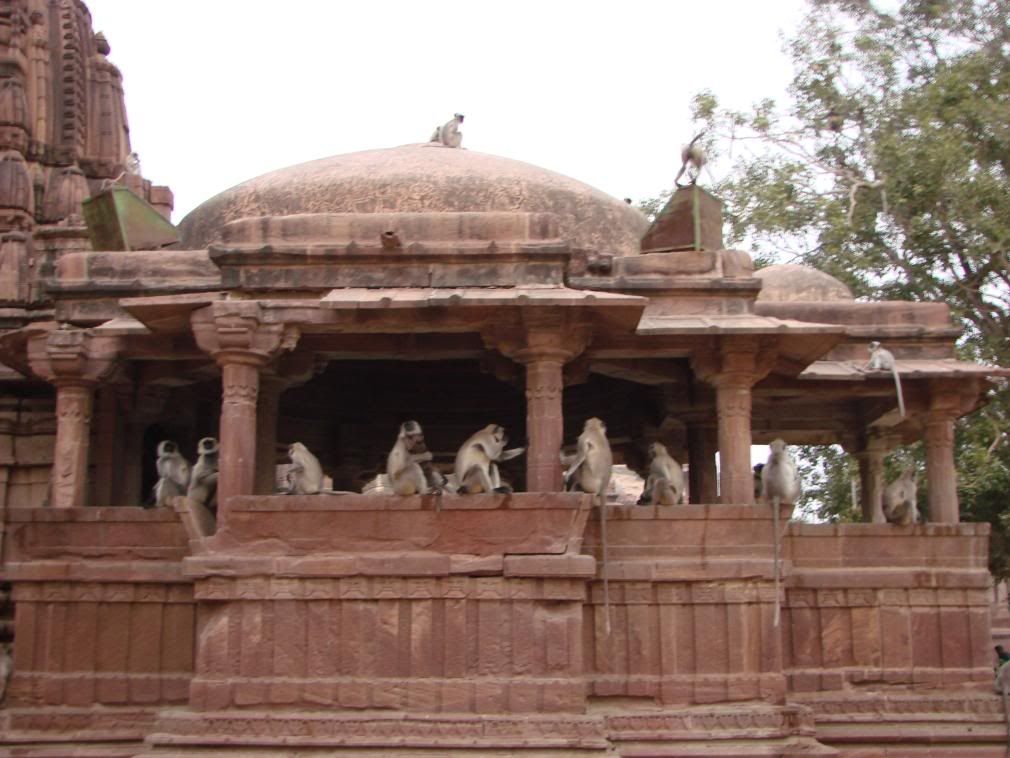 The park contained a series of well-preserved Hindu ruins, which were owned by these giant black-faced Macaque monkeys, the largest we’d ever seen. Half a dozen or so workers regularly fed them and we were almost intimidated as they outnumbered us humans about twenty to one. Atop one of the domed temples, a group of them were playing their version of king of the hill; one would sit atop while three or four others would run up and try to knock him off, incorporating flips and twirls like a pack of ninjas. It was mesmerizing. After awhile, we ventured off down this street but soon turned around as the stares we were getting from the men there did not seem friendly and some were outright menacing. Lastly, we visited the hall of heroes, which consisted of an entire galley of statues carved right into the rock. The statues consisted of deities from different religions followed by famous Rajput kings, some of whom held decapitated heads of their enemies.
The park contained a series of well-preserved Hindu ruins, which were owned by these giant black-faced Macaque monkeys, the largest we’d ever seen. Half a dozen or so workers regularly fed them and we were almost intimidated as they outnumbered us humans about twenty to one. Atop one of the domed temples, a group of them were playing their version of king of the hill; one would sit atop while three or four others would run up and try to knock him off, incorporating flips and twirls like a pack of ninjas. It was mesmerizing. After awhile, we ventured off down this street but soon turned around as the stares we were getting from the men there did not seem friendly and some were outright menacing. Lastly, we visited the hall of heroes, which consisted of an entire galley of statues carved right into the rock. The statues consisted of deities from different religions followed by famous Rajput kings, some of whom held decapitated heads of their enemies.
The following day we went on another day tour, this time to some of the outlying villages. Accompanying us was a gregarious Aussie family: JP, the father, reminded Jason of his uncle/godfather Danny; Kristin was studying criminology and shared some interesting insights about the difficulties of working with Aboriginal populations; and Oskar who was very bright and used words like presumptuous despite being only 13. At the first village, we took turns drinking very diluted opium water that is their customary welcome. We all looked in amusement as the local man finished the remaining half of the drink himself. After enjoying a great home-cooked meal at the next village we got to see how they make these incredible rugs, followed by encouragement to buy one, which we resisted. 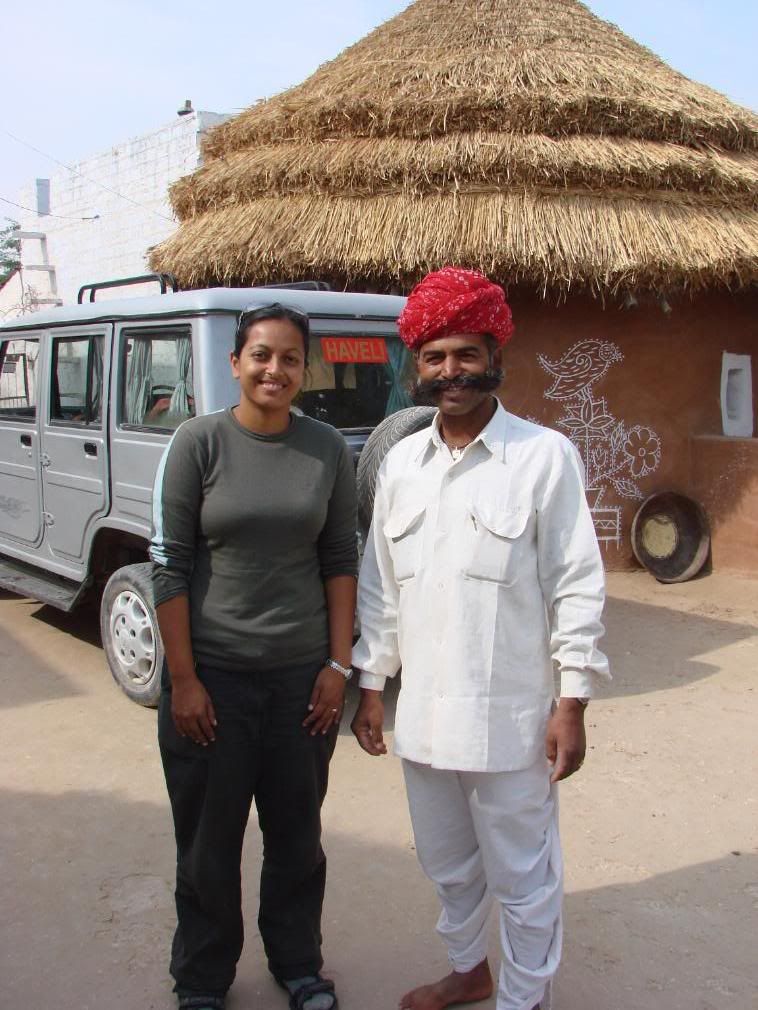 We couldn’t help but be amused at the men’s curly moustaches. The last village we got to see how they make earthenware pottery. We regretted not being able to purchase anything, but we knew we’d be back someday. That night, Jason purchased some sweets on the way back to our guesthouse. As he was eating a ladoo, a nearby cow caught a whiff of the food and gave us an imploring look to share our sweets. Although Jason looked at him and even said ‘no’ aloud, the cow started coming after us (or it). We hightailed it out of there and he eventually gave up the chase.
We couldn’t help but be amused at the men’s curly moustaches. The last village we got to see how they make earthenware pottery. We regretted not being able to purchase anything, but we knew we’d be back someday. That night, Jason purchased some sweets on the way back to our guesthouse. As he was eating a ladoo, a nearby cow caught a whiff of the food and gave us an imploring look to share our sweets. Although Jason looked at him and even said ‘no’ aloud, the cow started coming after us (or it). We hightailed it out of there and he eventually gave up the chase.
During our time in Jodhpur, we did purchase some nice textiles. The folks in our hotel offered to take us to their ‘brother’s’ place (in India, everyone is a ‘brother’) that was famous and supposedly frequented by many celebrities. The most recent was Madonna, who we had crossed paths with on our way to Jodhpur (she had departed for Udaipur the same day we arrived from there). We were led up three stories and couldn’t help but be impressed with the shear volume of textiles they had. While we sat waiting with a German couple for close to an hour while they closed another sale, we were shown a photo album of Bill Murray, Giorgio Armani, and Jason Schwartzman. After awhile, we just started looking through their stuff and became enamored with their exquisitely patterned Pashmina shawls. However, we suspected the price tag of 1500 rupees ($38) was inflated so we took off while the Germans got suckered.  A vital piece of information to always keep in mind when traveling is that whenever someone brings you to a shop they get a HUGE commission, sometimes as high as 50% so it is never wise to purchase something until you arrive on your own. On our final night, after another delectable dinner at Priya, we found the exact same shawls for 900, meaning the other place had inflated their prices by 66%! The owner even explained how the whole ‘famous-patron’ shtick is a ruse. Jason was tempted to purchase one of their ivory-handled daggers (for who knows what but feared having it confiscated at one of the many airports we still had left to pass through. However, he couldn’t resist buying (or showing it off in the above picture) one of the ‘retro-pimp’ shirts that he had seen so many of the locals wearing. The store had supposedly fixed prices and the shirt’s tag read 550 but when Jason was able to bargain in Hindi, the shop-owner gave in to ‘theen sow’ (300). As we packed our nearly overstuffed bags that night, we realized the discipline we had maintained throughout our trip to minimize our purchases was rapidly dissipating as we neared meeting up with Priti’s mother.
A vital piece of information to always keep in mind when traveling is that whenever someone brings you to a shop they get a HUGE commission, sometimes as high as 50% so it is never wise to purchase something until you arrive on your own. On our final night, after another delectable dinner at Priya, we found the exact same shawls for 900, meaning the other place had inflated their prices by 66%! The owner even explained how the whole ‘famous-patron’ shtick is a ruse. Jason was tempted to purchase one of their ivory-handled daggers (for who knows what but feared having it confiscated at one of the many airports we still had left to pass through. However, he couldn’t resist buying (or showing it off in the above picture) one of the ‘retro-pimp’ shirts that he had seen so many of the locals wearing. The store had supposedly fixed prices and the shirt’s tag read 550 but when Jason was able to bargain in Hindi, the shop-owner gave in to ‘theen sow’ (300). As we packed our nearly overstuffed bags that night, we realized the discipline we had maintained throughout our trip to minimize our purchases was rapidly dissipating as we neared meeting up with Priti’s mother.
When we had booked our overnight train to Jaisalmer, we were not sure what class to book because the woman behind the counter could not explain the difference and the guidebook was confusing. For those traveling to India, there are basically three options: 1) Sleeper—cheapest option with eight berths per car (three by three with two more opposite the aisle), no bed sheets, and no climate control; 2) 2AC—most expensive with only six berths per car (only two by two), with bed sheets and climate control; and 3) 3AC—hybrid of the two with eight berths, bed sheets and climate control. For any overnight journeys we highly recommend splurging on the 2AC or 3AC. Since it was just six hours and we didn’t know any better, we went with the cheapest option, sleeper class. One of the windows didn’t close, so the compartment was freezing cold and our sleeping bag liners didn’t help much. We were in the middle berths on each side, and the scumbag sleeping in the berth below Jason (meaning Jason couldn’t see him) stared at Priti all night, and even tried rubbing up against her several times as he walked by.
Thus, our arrival in Jaisalmer at six AM was a tired one, and we were immediately greeted with a group of obnoxious touts trying to get us into their hotels. We had read that the fort inside ‘Gold City’ was sinking and thus it was not environmentally responsible to stay inside it, so we went with a place outside of the fort. Continuing the Rajasthan pattern, the first room they gave us was awful and the toilet didn’t even work. This time we didn’t wait to demand another room and after Priti started yelling and we made for the exit, they gave us their best room for the same price we’d agreed to for the first sub-par room. Despite the early hour, they tried getting us to commit to booking a camel safari with them but we stalled, knowing we’d find it cheaper elsewhere. After catching up on sleep, we wandered into the fort and met some really nice guys, who invited Jason to play Karam, a board game akin to billiards with chips. After six straight losses, he bowed out. As we wandered around the labyrinthine Jaisalmer fort, we came across a jeweler shop that is renowned for its intricate engravings and many couples have their wedding bands made there with rows of symbols that represent their lives together. Although we didn’t buy any, we had fun coming up with our own list of symbols, like the St. Louis Arch, a saguaro cactus, Ganesh, and the earth, to name a few.
and after Priti started yelling and we made for the exit, they gave us their best room for the same price we’d agreed to for the first sub-par room. Despite the early hour, they tried getting us to commit to booking a camel safari with them but we stalled, knowing we’d find it cheaper elsewhere. After catching up on sleep, we wandered into the fort and met some really nice guys, who invited Jason to play Karam, a board game akin to billiards with chips. After six straight losses, he bowed out. As we wandered around the labyrinthine Jaisalmer fort, we came across a jeweler shop that is renowned for its intricate engravings and many couples have their wedding bands made there with rows of symbols that represent their lives together. Although we didn’t buy any, we had fun coming up with our own list of symbols, like the St. Louis Arch, a saguaro cactus, Ganesh, and the earth, to name a few.
The next day we took a camel safari out into the desert. Despite our misgivings about being on camels for about eight hours over two days, we thoroughly enjoyed it and this was one of the highlights of our trip thus far. We both developed a tremendous amount of respect for camels, which require very little food and water yet are so useful for long-distance transport in the desert. Plus, they are easygoing and not skittish like some horses.  We were glad our guides had not tied the camels together like another group we had seen, and they even let Jason’s camel, Kingfisher, ride ahead of the pack, allowing him a true Lawrence of Arabia feeling. The only drawbacks to Kingfisher were that he was not very friendly (wouldn’t let us pet him) and had the most horrible breath ever, which he kept belching up because he was constantly chewing shrubs. Interestingly camels move their jaws horizontally, rather than vertically, when they chew. Priti’s camel was much friendlier and even reached its head around to scratch its nose on her leg. Although riding became a bit uncomfortable by the end of the day, our legs were not too sore. The uninterrupted dunes stretched off into the horizon and were amazing to behold. After we stopped for the night, Jason had fun launching himself off the dunes into the soft silky sand.
We were glad our guides had not tied the camels together like another group we had seen, and they even let Jason’s camel, Kingfisher, ride ahead of the pack, allowing him a true Lawrence of Arabia feeling. The only drawbacks to Kingfisher were that he was not very friendly (wouldn’t let us pet him) and had the most horrible breath ever, which he kept belching up because he was constantly chewing shrubs. Interestingly camels move their jaws horizontally, rather than vertically, when they chew. Priti’s camel was much friendlier and even reached its head around to scratch its nose on her leg. Although riding became a bit uncomfortable by the end of the day, our legs were not too sore. The uninterrupted dunes stretched off into the horizon and were amazing to behold. After we stopped for the night, Jason had fun launching himself off the dunes into the soft silky sand. Our campsite was very close to the Pakistan border, and the guides themselves appeared more Pakistani or even Afghani in appearance, with dark skin and very light eyes. It was interesting to see them drinking water out of the same trough as their camels, which we surmised they’d been doing their entire lives. They were very friendly and cooked us a wonderful meal and sang Hindi film songs around the campfire. There were no tents, and Jason fell asleep by counting the shooting stars (he got to twenty).
Our campsite was very close to the Pakistan border, and the guides themselves appeared more Pakistani or even Afghani in appearance, with dark skin and very light eyes. It was interesting to see them drinking water out of the same trough as their camels, which we surmised they’d been doing their entire lives. They were very friendly and cooked us a wonderful meal and sang Hindi film songs around the campfire. There were no tents, and Jason fell asleep by counting the shooting stars (he got to twenty).
Upon our return from the camel safari, we discovered that all of the hotel owners would not give us a reasonable rate because they knew we had just returned from a camel safari, which is the real money-maker. So we returned to the travel agent that had booked us the safari and took a room inside the fort. Considering that most of the shops and many restaurants are located within the fort, we didn’t think our one night could be that environmentally harmful (don’t tell Al Gore). That night we went to the Dylan Café, so named in honor of Bob Dylan.  There we hung out with Om, who possessed a wealth of music and put all of our photos and videos on a DVD since we had been unable to find a good internet connection. The next morning, we awoke to discover that there was no water in our room (even though we had been told there was hot water). And because for some unknown reason, all the places have a 9 am checkout, we did not have time to shower for the third straight day. We both agreed we wouldn’t pay the full price since there was no water. When we informed the worker, he made a fuss and then promptly got his manager. As Priti argued with the manager in Hindi, he furtively directed the worker to go turn on the water, and afterwards went up to the room to show us that it did work and we were lying. This set Priti off and although we planned to give 150 instead of 200 rupees, his antics meant he wasn’t getting more than 100. He scoffed and said he wouldn’t accept that, so we just left without paying anything. But now we were stuck with our bags…oops. It took us an hour to find the Dylan Café; whenever we asked the locals its whereabouts and spelled it, they called it ‘dialin’, much to our bemusement.
There we hung out with Om, who possessed a wealth of music and put all of our photos and videos on a DVD since we had been unable to find a good internet connection. The next morning, we awoke to discover that there was no water in our room (even though we had been told there was hot water). And because for some unknown reason, all the places have a 9 am checkout, we did not have time to shower for the third straight day. We both agreed we wouldn’t pay the full price since there was no water. When we informed the worker, he made a fuss and then promptly got his manager. As Priti argued with the manager in Hindi, he furtively directed the worker to go turn on the water, and afterwards went up to the room to show us that it did work and we were lying. This set Priti off and although we planned to give 150 instead of 200 rupees, his antics meant he wasn’t getting more than 100. He scoffed and said he wouldn’t accept that, so we just left without paying anything. But now we were stuck with our bags…oops. It took us an hour to find the Dylan Café; whenever we asked the locals its whereabouts and spelled it, they called it ‘dialin’, much to our bemusement.
That evening, as we boarded the long, long, long train to Delhi, we were sad to be leaving Rajasthan because it is an amazing place but we vowed to return, especially since we didn’t get to see some of the other highlights like Jaipur, the ‘pink city’.  There is a reason this is the Indian state that receives the most tourists each year and in our opinion no visit to the sub-continent would be complete without seeing it. At the same time, we were very excited to see Priti’s mother in Delhi, as well as the rest of her family in Bihar, all of which will be detailed in the next blog entry.
There is a reason this is the Indian state that receives the most tourists each year and in our opinion no visit to the sub-continent would be complete without seeing it. At the same time, we were very excited to see Priti’s mother in Delhi, as well as the rest of her family in Bihar, all of which will be detailed in the next blog entry.
 town was an interesting ride, as the streets were incredibly narrow and the driver had to stop several times and back up to let the oncoming vehicle squeeze by. We walked around for awhile and found a guesthouse with a nice view of the
town was an interesting ride, as the streets were incredibly narrow and the driver had to stop several times and back up to let the oncoming vehicle squeeze by. We walked around for awhile and found a guesthouse with a nice view of the  We noticed people would stop and give them mythai (me-tie=sweets), and Jason was jealous when he saw on lucky cow chomping on a handful of ladoos. Our first sight was a nearby Hindu temple; inside were a group of mostly older women sitting on the floor, chanting bhajuns (worship songs) in front of a black avatar of Shiva. In the afternoon we visited the
We noticed people would stop and give them mythai (me-tie=sweets), and Jason was jealous when he saw on lucky cow chomping on a handful of ladoos. Our first sight was a nearby Hindu temple; inside were a group of mostly older women sitting on the floor, chanting bhajuns (worship songs) in front of a black avatar of Shiva. In the afternoon we visited the  On our way back to our room, we listened to a local musician playing a Rajasthani stringed instrument at one of the lakeside ghats, which are platforms with steps leading down to the water. Jason put a down payment on a CD because he wanted to hear it first since it was just a copied disc. We agreed if we liked it we’d buy it but if not, we’d get our money back. As we ate an uninspiring dinner in the guesthouse restaurant, we tried listening to it but only a few of the tracks actually contained music. When we saw him again the following day, he had just made another sale to an older couple. When Jason explained the problem the musician became very defensive. The female tourist snidely remarked, “who cares, it’s only 300 rupies” to which Jason immediately offered to sell it to her for that price, which she of course declined. The musician wasn’t going to return our money until Priti started to raise her voice in Hindi, after which he held up his end of our agreement.
On our way back to our room, we listened to a local musician playing a Rajasthani stringed instrument at one of the lakeside ghats, which are platforms with steps leading down to the water. Jason put a down payment on a CD because he wanted to hear it first since it was just a copied disc. We agreed if we liked it we’d buy it but if not, we’d get our money back. As we ate an uninspiring dinner in the guesthouse restaurant, we tried listening to it but only a few of the tracks actually contained music. When we saw him again the following day, he had just made another sale to an older couple. When Jason explained the problem the musician became very defensive. The female tourist snidely remarked, “who cares, it’s only 300 rupies” to which Jason immediately offered to sell it to her for that price, which she of course declined. The musician wasn’t going to return our money until Priti started to raise her voice in Hindi, after which he held up his end of our agreement.  of the guesthouses in town. Somehow, we managed not to see it. The visit was also educational because we got to see some of the solar-powered vehicles that are growing in popularity in what is coming to be called the “green city.” For some reason, each of the cities in Rajasthan, like the so-called revolutions in the former
of the guesthouses in town. Somehow, we managed not to see it. The visit was also educational because we got to see some of the solar-powered vehicles that are growing in popularity in what is coming to be called the “green city.” For some reason, each of the cities in Rajasthan, like the so-called revolutions in the former  forces for the siege but only managed to hold it for two days. As we wandered around, we understood how the fort was so secure while marveling at the vastness of the compound. There were scores of temples dotted on the landscape and we ventured off the main loop to visit one of them.
forces for the siege but only managed to hold it for two days. As we wandered around, we understood how the fort was so secure while marveling at the vastness of the compound. There were scores of temples dotted on the landscape and we ventured off the main loop to visit one of them.  When we circuitously arrived at a beautiful temple we had spotted from atop the fort, we were the only ones around, save for one boy who seemed to be some sort of security guard. Although the temple was locked, we enjoyed the solitude away from the hordes of school kids on field trips.
When we circuitously arrived at a beautiful temple we had spotted from atop the fort, we were the only ones around, save for one boy who seemed to be some sort of security guard. Although the temple was locked, we enjoyed the solitude away from the hordes of school kids on field trips. Jainism is an offshoot of Hinduism whose adherents are strictly vegetarian. The architecture of the temple was incredible, with thousands of stone columns, each one unique. We had to remove our shoes before entering (as in most temples in
Jainism is an offshoot of Hinduism whose adherents are strictly vegetarian. The architecture of the temple was incredible, with thousands of stone columns, each one unique. We had to remove our shoes before entering (as in most temples in 
 And now, another small rant. It is common for other tourists to ask us to take their picture and we usually ask them to reciprocate. It has been our experience that many of these people show little to no concern for how the pictures turn out. For example, at the
And now, another small rant. It is common for other tourists to ask us to take their picture and we usually ask them to reciprocate. It has been our experience that many of these people show little to no concern for how the pictures turn out. For example, at the  On our way to the guesthouse, we looked aghast at the open sewers that flowed alongside the streets. Similar to
On our way to the guesthouse, we looked aghast at the open sewers that flowed alongside the streets. Similar to  The park contained a series of well-preserved Hindu ruins, which were owned by these giant black-faced Macaque monkeys, the largest we’d ever seen. Half a dozen or so workers regularly fed them and we were almost intimidated as they outnumbered us humans about twenty to one. Atop one of the domed temples, a group of them were playing their version of king of the hill; one would sit atop while three or four others would run up and try to knock him off, incorporating flips and twirls like a pack of ninjas. It was mesmerizing. After awhile, we ventured off down this street but soon turned around as the stares we were getting from the men there did not seem friendly and some were outright menacing. Lastly, we visited the hall of heroes, which consisted of an entire galley of statues carved right into the rock. The statues consisted of deities from different religions followed by famous Rajput kings, some of whom held decapitated heads of their enemies.
The park contained a series of well-preserved Hindu ruins, which were owned by these giant black-faced Macaque monkeys, the largest we’d ever seen. Half a dozen or so workers regularly fed them and we were almost intimidated as they outnumbered us humans about twenty to one. Atop one of the domed temples, a group of them were playing their version of king of the hill; one would sit atop while three or four others would run up and try to knock him off, incorporating flips and twirls like a pack of ninjas. It was mesmerizing. After awhile, we ventured off down this street but soon turned around as the stares we were getting from the men there did not seem friendly and some were outright menacing. Lastly, we visited the hall of heroes, which consisted of an entire galley of statues carved right into the rock. The statues consisted of deities from different religions followed by famous Rajput kings, some of whom held decapitated heads of their enemies. We couldn’t help but be amused at the men’s curly moustaches. The last village we got to see how they make earthenware pottery. We regretted not being able to purchase anything, but we knew we’d be back someday. That night, Jason purchased some sweets on the way back to our guesthouse. As he was eating a ladoo, a nearby cow caught a whiff of the food and gave us an imploring look to share our sweets. Although Jason looked at him and even said ‘no’ aloud, the cow started coming after us (or it). We hightailed it out of there and he eventually gave up the chase.
We couldn’t help but be amused at the men’s curly moustaches. The last village we got to see how they make earthenware pottery. We regretted not being able to purchase anything, but we knew we’d be back someday. That night, Jason purchased some sweets on the way back to our guesthouse. As he was eating a ladoo, a nearby cow caught a whiff of the food and gave us an imploring look to share our sweets. Although Jason looked at him and even said ‘no’ aloud, the cow started coming after us (or it). We hightailed it out of there and he eventually gave up the chase.




There is a reason this is the Indian state that receives the most tourists each year and in our opinion no visit to the sub-continent would be complete without seeing it. At the same time, we were very excited to see Priti’s mother in
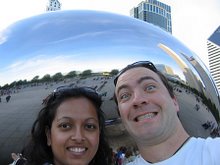


No comments:
Post a Comment